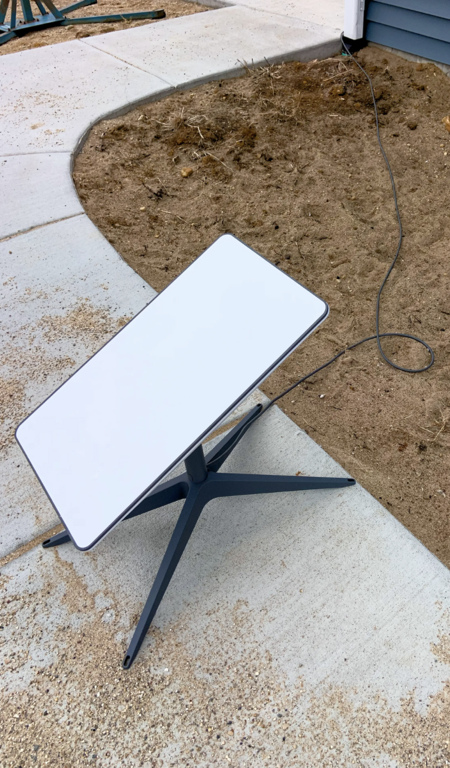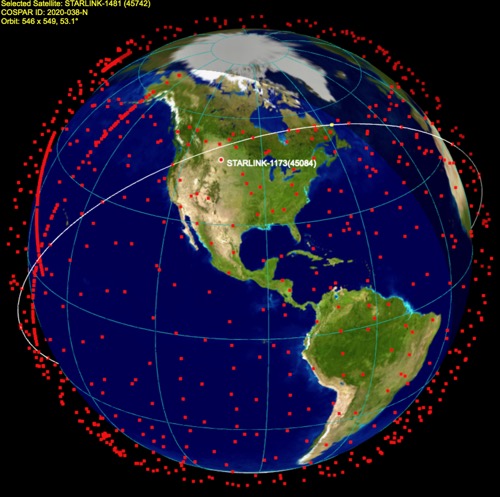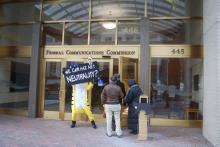
Recent Trump administration changes to a massive federal broadband grant program are lowering standards for broadband access, shifting the focus away from affordability and equity, and potentially redirecting billions of dollars away from future-proof fiber networks toward slower, more expensive satellite options that don’t seem likely to fix U.S. broadband woes.
But states, worried about losing an historic round of broadband grants, may be too intimidated to be up front about the potential downside of changes the Trump administration calls “the benefit of the bargain.”
That’s the early story coming out of states like Tennessee, Colorado, and Texas, where state leaders are being forced to dramatically revamp billions of dollars in Broadband, Equity, Access, and Deployment (BEAD) grant planning.
In all three states the changes have introduced new delays and lowered last mile quality control standards. But an early look at the revamped bidding process in all three states shows that billions of dollars are likely being redirected away from locally-owned fiber networks to billionaire-owned low-Earth-orbit (LEO) satellite broadband options insufficient to the task.

The Trump NTIA changed BEAD program rules on June 6 with an eye on eliminating labor, climate, and affordability requirements. The changes were primarily sold as an effort to lower program costs and improve government efficiency.
But the changes introduced profound new bidding advantages worth billions to two key Trump allies: Elon Musk’s capacity-constrained LEO satellite broadband network Starlink; and Jeff Bezos’ fledgling Project Kuiper LEO constellation.
These rushed BEAD program changes ignore several key problems: these new satellite offerings often aren’t affordable to people most in need of connection, may be harmful to the environment, and lack the network capacity to actually scale to meet demand.
The NTIA’s original guidance for the BEAD program was portrayed as “technology neutral,” but in most instances the goal was to prioritize fiber technology with an eye on increased capacity, consumer affordability, and building telecommunication infrastructure that will last for decades to come. From there, fixed wireless, and satellite, in that order, would help fill in any remaining gaps.
The changes shuffle that agenda, potentially putting LEO satellite at the top of the bidding pecking order.
The changes to BEAD also introduce significant new delays for a program Republicans had spent much of last election season criticizing for progressing too slowly. If states fail to adapt to the administration’s demands, they risk losing funding entirely.

Commerce Secretary Howard Lutnick has indicated the NTIA will approve state plans that are the most "efficient" and "cost-effective,” raising the risk that state plans that aren’t appropriately deferential to Starlink – or include approaches the Trump administration doesn’t approve of (like financing for community-owned broadband networks, or including affordability requirements) – may face additional delays or see their funding vanish entirely.
“The American people will get the benefit of the bargain, with connectivity delivered around the country at a fraction of the cost of the original program,” said Commerce Secretary Howard Lutnick in a prepared statement.
The Problem: LEO Satellite Is Congested, Expensive, And Environmentally Harmful
While LEO satellites may promise undeniably lower up front rural deployment costs, there’s growing evidence the technology is incapable of actually accomplishing the task at hand.
Recent analysis by broadband researchers at X-Lab found that Starlink struggles to deliver the FCC’s already flimsy definition of broadband – 100 megabits per second (Mbps) down, 20 Mbps up – in any areas where Starlink subscribership exceeds 6 households per square mile.
(Listen to X-Lab founder Sascha Meinrath discuss the analysis and break down what Starlink gets right—and wrong—about solving the digital divide on our latest Community Broadband Bits podcast here):
The more users using the network, the worse network performance will be. That raises some serious questions about the wisdom of suddenly introducing millions of new taxpayer subsidized locations to the already congested network.
“What this analysis presents is that across many geographic areas Starlink may not be a qualified bidder as it may be unable to attain the required 100/20 Mbps service level – and, in deploying Starlink services, may actually degrade pre-existing users’ services to the point that they no longer receive minimal broadband speeds,” the researchers wrote.

But an administration that has taken a hatchet to regulatory independence and telecom oversight isn’t likely to hold LEO satellite providers accountable should winning projects fail to deliver promised speeds, potentially harkening to some of the problems seen in the FCC’s controversial Rural Digital Opportunity Fund (RDOF).
Starlink is already deemed too expensive for many rural Americans who need it most. But the network’s congestion problems make the problem worse: Starlink is increasingly implementing “congestion charges” from $100 to $750 in areas where the network can’t handle capacity demands and the company wants to deter use.
Starlink’s technology has also faced criticism that it irreparably harms astronomical research, while scientists have also found the disposable nature of the satellites may result in a deterioration of the ozone layer as they consistently burn up in orbital re-entry.

Keeping the constellation funded and in orbit is also not guaranteed, and the erratic and conspiratorial behavior of the nation’s richest billionaire also raises questions about company stability.
Musk’s Starlink was broadly criticized during the first Trump administration when it received $886 million dollars to deploy Starlink to airport parking lots and traffic medians under an earlier, different subsidy program. The Biden FCC ultimately walked back most of these subsidies, expressing concern that Starlink was likely incapable of delivering consistent speeds that met the FCC’s definition of broadband at scale.
Meanwhile, the law that created the BEAD program, the Infrastructure Investment and Jobs Act, set a very explicit set of criteria for the grants, including the prioritization of low-income deployments, deployment speed, bidder competency, and adherence to existing U.S. labor laws (not historically an Elon Musk strong point).
“The federal statute does not prioritize projects based upon cost-per-passing – which is the singular prioritization metric used by NTIA,” Penn State telecom expert Sascha Meinrath tells ILSR.
“This would seem in direct opposition to an explicit statutory mandate – a ‘shall’ statement” within the Trump administration’s NTIA changes, he added.
In short the lower up-front costs of LEO satellite broadband come with significant longer-term downsides that dramatically undermine the cost proposition for states, and the prioritization of LEO satellite may not even be in accordance with the grant program’s underlying law.
Yet there’s ample evidence that as states try to appease the Trump administration's new guidelines to receive funds, they may be incentivized to simply ignore these potential pitfalls, settling for “good enough” broadband that imperils the program’s full potential.
Lower Standards, Real World Harms
The Tennessee Department of Economic and Community Development (TNECD) originally released its list of initial BEAD round applications in April. But after Trump NTIA changes, the TNECD released its “Benefit of the Bargain” list of updated bidding applications on July 22 (Telecompetitor did a useful breakdown of the differences in coverage and bids).
The comparison found that Tennessee saw 298 applications in its initial round of BEAD bidding, and 541 in its Benefit of the Bargain round, with most of the difference coming with emboldened LEO satellite providers.
The differences show that the Trump administration’s BEAD changes have resulted in SpaceX’s Starlink and Amazon’s Project Kuiper flooding the Tennessee office with applications for taxpayer money, submitting more than twice as many broadband grant applications as fiber builders, while requesting roughly 10 times less funding.
The lower standards have also resulted in some entrenched regional telecom monopolies, like Comcast, backing away from plans to deploy higher-capacity fiber in Tennessee, instead promising to deploy slower, more-upstream speed constrained traditional cable access.

In Colorado, state leaders say they’re frustrated by dramatic, last minute changes to the BEAD program, and note that many local fiber ISPs not only risk losing out on bidding to satellite alternatives, they spent significant amounts of money on their original applications that can’t be recouped.
In Texas, the revamped bidding process looks a lot like Tennessee and Colorado, with Elon Musk’s Starlink in the lead for billions in new subsidies, much of which may have gone to more locally optimized future-proof fiber alternatives or local cooperatives.
While time will tell, early evidence suggests that Musk’s Starlink is likely to dominate the final bidding despite little evidence the network is up to the task. But states may have little choice but to stifle criticism, lower their standards and embrace inferior technology if they want to stay in the good graces of the Trump administration and avoid losing billions in historic subsidies.
Acknowledged or not, the lower standards, elimination of affordability requirements, and fixation on the “cheapest” deployment options will have very real impacts on those stuck on the wrong side of broadband affordability and the digital divide for decades to come. If Starlink can’t handle the mass infusion of new subsidized users, the problems (and complaints) won’t be subtle.
Header image of Elon Musk surveying exploded rocket damage courtesy of Wikimedia Commons, Creative Commons license, Attribution 2.0 Generic
Inline image of US Treasury Department building courtesy of Wikimedia Commons, Creative Commons license, Attribution-ShareAlike 4.0 International
Inline image of Commerce Secretary Howard Lutnick testifying before Congress courtesy of Broadband Breakfast
Inline image of man standing on deck of yacht next to his Starlink satellite dish courtesy of Steve Jurvetson on Flickr, Creative Commons license, Attribution 2.0 Generic
Inline image of Starlink home satellite dish courtesy of Wikimedia Commons, Creative Commons license, CC0 1.0 Universal
Inline image of Starlink satellite constellation courtesy of Wikimedia Commons, Creative Commons, Attribution 2.0 Generic







